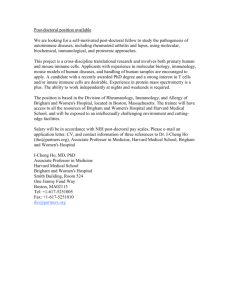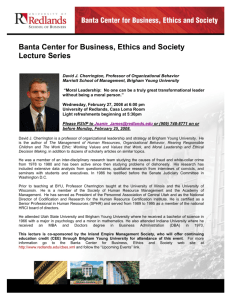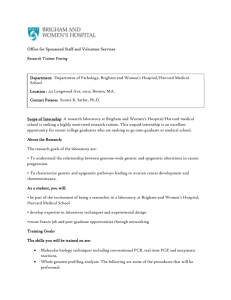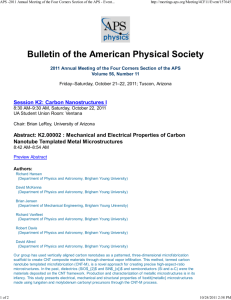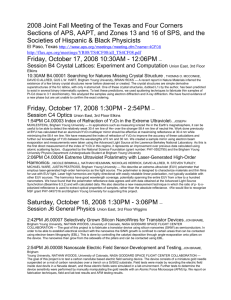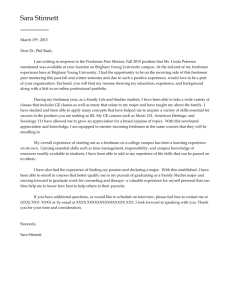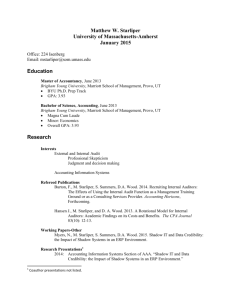Flipped Classroom (Final_3)
advertisement
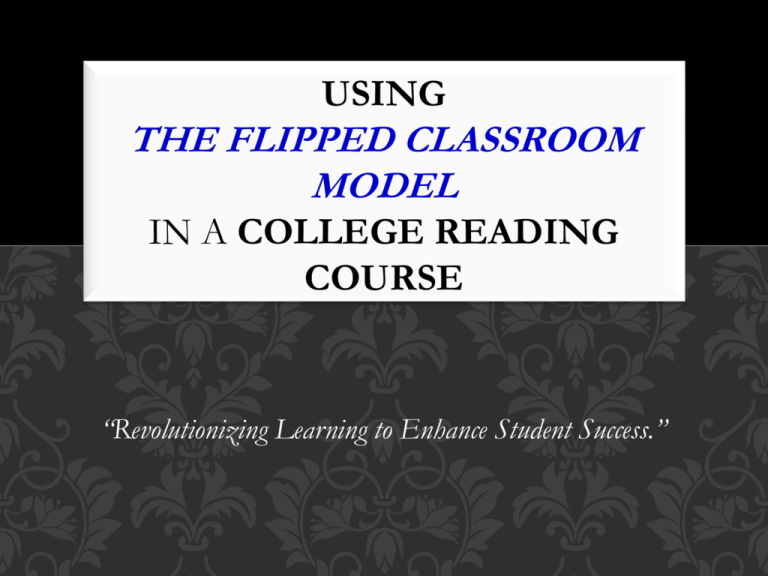
USING THE FLIPPED CLASSROOM MODEL IN A COLLEGE READING COURSE “Revolutionizing Learning to Enhance Student Success.” TOPICS COVERED IN THIS PRESENTATION Description of • the study • the flipped classroom • positive flipped outcomes • instructional activities designed to achieve flipped outcomes • the course itself • the results of the study BRIGHAM YOUNG UNIVERSITY STUDENT DEVELOPMENT & CENTER FOR TEACHING & LEARNING PURPOSE OF THE STUDY Determine 1. the degree to which flipped classroom outcomes occurred in a college reading course (student survey). 2. the instructional activities that influenced those outcomes (student survey). BRIGHAM YOUNG UNIVERSITY STUDENT DEVELOPMENT & CENTER FOR TEACHING & LEARNING DEFINITION OF THE FLIPPED CLASSROOM BRIGHAM YOUNG UNIVERSITY STUDENT DEVELOPMENT & CENTER FOR TEACHING & LEARNING STUDENTS GAIN FUNDAMENTAL KNOWLEDGE PRIOR TO COMING TO CLASS BRIGHAM YOUNG UNIVERSITY STUDENT DEVELOPMENT & CENTER FOR TEACHING & LEARNING SO THEY CAN THEN APPLY THAT KNOWLEDGE IN CLASS BRIGHAM YOUNG UNIVERSITY STUDENT DEVELOPMENT & CENTER FOR TEACHING & LEARNING CONTRAST WITH TRADITIONAL MODEL Traditional Pre Class Students prepare for lecture Flipped Pre Class Students are held accountable to learn new course material In Class Instructor lectures on mostly pre class material In Class Class debriefs pre-class work Instructor provides realtime feedback on inclass assignments Post/Pre Class Studentsapply lecture thru HW prepare for next class Post/Pre Class Studentsfinish inclass assignments prepare for next class Students receive feedback on HW a day or week later (not in real time) HOW DID THE FLIPPED CLASSROOM GET STARTED? Desire to Overcome the Coverage vs. Depth Challenge Advent of Digital Technology BRIGHAM YOUNG UNIVERSITY STUDENT DEVELOPMENT & CENTER FOR TEACHING & LEARNING An Effectively Flipped Classroom is most appropriate when there is a performance-mastery versus a content-delivery emphasis BRIGHAM YOUNG UNIVERSITY STUDENT DEVELOPMENT & CENTER FOR TEACHING & LEARNING FLIPPED OUTCOMES FROM THE STUDENT’S PERSPECTIVE Meaningful Better Learning Hands-on Retention Learning Skills Expanded in-Class Several Ways to Learn the Material Instructor more aware of Student Abilities Material that is more easily reviewable. Meaningful Peer- to-Peer Interaction Easier to Catch Up on Missed Material Students better prepared for Class Meaningful Instructor Interaction Students able to Go at Own Pace A SYNTHESIS FROM THE FOLLOWING SOURCES: Ash, 2012; Baker, 2000; Bathker, 2013; Bennett et al., 2011; Bergman & Sams, 2008, Davies, 2013; Hertz, 2012; Hughes, 2012; Gajjar, 2013; Kahn, 2011; Lage et al., 2000; Spencer et al., 2011; Talbert, 2012; Tucker, 2012 BRIGHAM YOUNG UNIVERSITY STUDENT DEVELOPMENT & CENTER FOR TEACHING & LEARNING FLIPPED OUTCOMES FROM THE INSTRUCTOR’S PERSPECTIVE Diminished Lecture Prep Time Greater Student- Friendly Instruction (preclass) Able to develop better Applicationtype activities In Class Reach Struggling and Advanced Students at Same Time A SYNTHESIS FROM THE FOLLOWING SOURCES: Ash, 2012; Baker, 2000; Bathker, 2013; Bennett et al., 2011; Bergman & Sams, 2008, Davies, 2013; Hertz, 2012; Hughes, 2012; Gajjar, 2013; Kahn, 2011; Lage et al., 2000; Spencer et al., 2011; Talbert, 2012; Tucker, 2012 BRIGHAM YOUNG UNIVERSITY STUDENT DEVELOPMENT & CENTER FOR TEACHING & LEARNING MISCONCEPTIONS Flipping means: Content coverage will be sacrificed A fad that will go away Students working without structure Simply an online course Students staring at a computer in class Teachers replaced by videos A SYNTHESIS FROM THE FOLLOWING SOURCES: Ash, 2012; Baker, 2000; Bathker, 2013; Bennett et al., 2011; Bergman & Sams, 2008, Davies, 2013; Hertz, 2012; Hughes, 2012; Gajjar, 2013; Kahn, 2011; Lage et al., 2000; Spencer et al., 2011; Talbert, 2012; Tucker, 2012 BRIGHAM YOUNG UNIVERSITY STUDENT DEVELOPMENT & CENTER FOR TEACHING & LEARNING CHALLENGES Students adjust to new learning schedule Upfront cost for Instructors Instructors letting go of their inclass role as primary information conveyer Making time to grade student performance Creating a culture of class preparedness A SYNTHESIS FROM THE FOLLOWING SOURCES: Ash, 2012; Baker, 2000; Bathker, 2013; Bennett et al., 2011; Bergman & Sams, 2008, Davies, 2013; Hertz, 2012; Hughes, 2012; Gajjar, 2013; Kahn, 2011; Lage et al., 2000; Spencer et al., 2011; Talbert, 2012; Tucker, 2012 BRIGHAM YOUNG UNIVERSITY STUDENT DEVELOPMENT & CENTER FOR TEACHING & LEARNING OUR COURSE Advanced Reading Strategies for College Success BRIGHAM YOUNG UNIVERSITY STUDENT DEVELOPMENT & CENTER FOR TEACHING & LEARNING Elective course for graduation credit BRIGHAM YOUNG UNIVERSITY STUDENT DEVELOPMENT & CENTER FOR TEACHING & LEARNING 2 credit class taught twice a week for 50min BRIGHAM YOUNG UNIVERSITY STUDENT DEVELOPMENT & CENTER FOR TEACHING & LEARNING Four sections taught by four different instructors. BRIGHAM YOUNG UNIVERSITY STUDENT DEVELOPMENT & CENTER FOR TEACHING & LEARNING 20-25 students per section BRIGHAM YOUNG UNIVERSITY STUDENT DEVELOPMENT & CENTER FOR TEACHING & LEARNING Mostly Juniors and Seniors take the course with an average of 26 on the reading section of the ACT BRIGHAM YOUNG UNIVERSITY STUDENT DEVELOPMENT & CENTER FOR TEACHING & LEARNING PURPOSES OF THE COURSE BRIGHAM YOUNG UNIVERSITY STUDENT DEVELOPMENT & CENTER FOR TEACHING & LEARNING STUDENTS WILL - Describe reading principles and strategies. BRIGHAM YOUNG UNIVERSITY STUDENT DEVELOPMENT & CENTER FOR TEACHING & LEARNING STUDENTS WILL - Explain 1. 2. 3. 4. what the strategy is, why it is important, how to do it, and when or under what conditions to apply it. BRIGHAM YOUNG UNIVERSITY STUDENT DEVELOPMENT & CENTER FOR TEACHING & LEARNING STUDENTS WILL - Explain what reading is, especially academic reading. BRIGHAM YOUNG UNIVERSITY STUDENT DEVELOPMENT & CENTER FOR TEACHING & LEARNING STUDENTS WILL - Select, adapt, and practice the reading strategies that make the greatest contribution to their understanding, learning and reasoning from their college texts. BRIGHAM YOUNG UNIVERSITY STUDENT DEVELOPMENT & CENTER FOR TEACHING & LEARNING STUDENTS WILL - Demonstrate improvement from their baseline comprehension rates and reading speed . BRIGHAM YOUNG UNIVERSITY STUDENT DEVELOPMENT & CENTER FOR TEACHING & LEARNING READING COMPREHENSION Students master 26 reading comprehension strategies that are divided into three categories 6 strategies 10 strategies 10 strategies BRIGHAM YOUNG UNIVERSITY STUDENT DEVELOPMENT & CENTER FOR TEACHING & LEARNING READING COMPREHENSION Students master 26 reading comprehension strategies that are divided into three categories SURVIVAL Reading Strategies Covered in the 1st Half of the Semester 6 strategies 10 strategies 10 strategies BRIGHAM YOUNG UNIVERSITY STUDENT DEVELOPMENT & CENTER FOR TEACHING & LEARNING READING COMPREHENSION Students master 26 reading comprehension strategies that are divided into three categories SCHOLARLY Reading Strategies Covered in the 2nd Half of the Semester 6 strategies 10 strategies 10 strategies BRIGHAM YOUNG UNIVERSITY STUDENT DEVELOPMENT & CENTER FOR TEACHING & LEARNING Layered Reading Framework BRIGHAM YOUNG UNIVERSITY STUDENT DEVELOPMENT & CENTER FOR TEACHING & LEARNING Before Strategies BRIGHAM YOUNG UNIVERSITY STUDENT DEVELOPMENT & CENTER FOR TEACHING & LEARNING During Strategies BRIGHAM YOUNG UNIVERSITY STUDENT DEVELOPMENT & CENTER FOR TEACHING & LEARNING After Strategies BRIGHAM YOUNG UNIVERSITY STUDENT DEVELOPMENT & CENTER FOR TEACHING & LEARNING INCREASING READING SPEED They also master 7 speeding –up reading drills that help them increase their BRIGHAM YOUNG UNIVERSITY STUDENT DEVELOPMENT & CENTER FOR TEACHING & LEARNING SPEEDING-UP ACTIVITIES Students use a device called “ReadMate” to pace themselves as they use different speeding-up strategies. They track their progress on a “Speeding-up Chart” They demonstrate their ability to perform each speeding-up drill in a “Speeding-up Lab” BRIGHAM YOUNG UNIVERSITY STUDENT DEVELOPMENT & CENTER FOR TEACHING & LEARNING HOW THE CLASS IS SET UP Pre-Class Activities Strategy Explanation Strategy Demonstration Strategy 1st Practice + Meta-cognitive Reflection In-Class Activities Debrief Pre-Class Coached Practice + Meta-cognitive Reflection Debrief In-Class BRIGHAM YOUNG UNIVERSITY STUDENT DEVELOPMENT & CENTER FOR TEACHING & LEARNING HOW THE CLASS IS SET UP Pre-Class Activities Strategy Explanation Strategy Demonstration Strategy 1st Practice + Meta-cognitive Reflection In-Class Activities Debrief Pre-Class Coached Practice + Meta-cognitive Reflection Debrief In-Class All done on readings for other classes BRIGHAM YOUNG UNIVERSITY STUDENT DEVELOPMENT & CENTER FOR TEACHING & LEARNING EXAMPLE Pre-Class Activities Strategy Explanation Strategy Demonstration Strategy 1st Practice + Meta-cognitive Reflection In-Class Activities Debrief Pre-Class Coached Practice + Meta-cognitive Reflection Strategy 1st Practice BRIGHAM YOUNG UNIVERSITY STUDENT DEVELOPMENT & CENTER FOR TEACHING & LEARNING EXAMPLE Pre-Class Activities Strategy Explanation Strategy Demonstration Strategy 1st Practice In-Class Activities Debrief Pre-Class Coached Practice Strategy 1st Practice BRIGHAM YOUNG UNIVERSITY STUDENT DEVELOPMENT & CENTER FOR TEACHING & LEARNING Read the principles behind the use of the strategy. BRIGHAM YOUNG UNIVERSITY STUDENT DEVELOPMENT & CENTER FOR TEACHING & LEARNING EXAMPLE Pre-Class Activities Strategy Explanation Strategy Demonstration Strategy 1st Practice + Meta-cognitive Reflection In-Class Activities Debrief Pre-Class Coached Practice + Meta-cognitive Reflection Debrief In-Class BRIGHAM YOUNG UNIVERSITY STUDENT DEVELOPMENT & CENTER FOR TEACHING & LEARNING Demo Begins BRIGHAM YOUNG UNIVERSITY STUDENT DEVELOPMENT & CENTER FOR TEACHING & LEARNING K-W-L & THE MORE YOU KNOW Demo Welcome to Now let’s go to the ThinkSheet K-W-L & The More You for this Strategy. Know DEMO. DEMO Before going on, be sure to read pp. 59–63 in the course handbook. BRIGHAM YOUNG UNIVERSITY STUDENT DEVELOPMENT & CENTER FOR TEACHING & LEARNING Notice the DEMO BEFORE BRIGHAM YOUNG UNIVERSITY STUDENT DEVELOPMENT & CENTER FOR TEACHING & LEARNING DEMO DURING BRIGHAM YOUNG UNIVERSITY STUDENT DEVELOPMENT & CENTER FOR TEACHING & LEARNING DEMO & AFTER BRIGHAM YOUNG UNIVERSITY STUDENT DEVELOPMENT & CENTER FOR TEACHING & LEARNING components DEMO of this strategy BRIGHAM YOUNG UNIVERSITY STUDENT DEVELOPMENT & CENTER FOR TEACHING & LEARNING DEMO Now, I will introduce you to the text I will be using this strategy with. BRIGHAM YOUNG UNIVERSITY STUDENT DEVELOPMENT & CENTER FOR TEACHING & LEARNING DEMO Chapter 17 of the Physical Science Text, entitled: BRIGHAM YOUNG UNIVERSITY STUDENT DEVELOPMENT & CENTER FOR TEACHING & LEARNING DEMO Before starting with K-W-L, I previewed the chapter using Skeleton. BRIGHAM YOUNG UNIVERSITY STUDENT DEVELOPMENT & CENTER FOR TEACHING & LEARNING I then did a THIEVVES with DEMO Snatches BRIGHAM YOUNG UNIVERSITY STUDENT DEVELOPMENT & CENTER FOR TEACHING & LEARNING And now for the K – W DEMO (What I Know & What I Want to know) BRIGHAM YOUNG UNIVERSITY STUDENT DEVELOPMENT & CENTER FOR TEACHING & LEARNING Here is all that I know about the Periodic Table: Jane Doe Feb 14 008 Chapter 17 “Periodic Table” I studied the periodic table in 9th grade (Mr. Shaw’s class) but Uranium (92nd element) was the last element then. Why didn’t I learn about all 111 elements? DEMO The atomic # is the # of protons and the # of neutrons combined (I think?) Ion has to do with the number of electrons out of balance with protons. The nucleus has protons and neutrons in it. These are made up of quarks. (But I ‘m fuzzy on what they are.) BRIGHAM YOUNG UNIVERSITY STUDENT DEVELOPMENT & CENTER FOR TEACHING & LEARNING Once I begin reading I will evaluate my prior knowledge by marking either correct with a (check) and incorrect with a (zero) in the before column, like so: Jane Doe Feb 14 008 Chapter 17 “Periodic Table” I studied the periodic table in 9th grade (Mr. Shaw’s class) but Uranium (92nd element) was the last element then. Why didn’t I learn about all 111 elements? The atomic # is the # of protons and the # of neutrons combined (I think?) Ion has to do with the number of electrons out of balance with protons. The nucleus has protons and neutrons in it. These are made up of quarks. (But I ‘m fuzzy on what they are.) BRIGHAM YOUNG UNIVERSITY STUDENT DEVELOPMENT & CENTER FOR TEACHING & LEARNING Now Here for isthe what DURING I WANT/NEED portion of to theknow. strategy Jane Doe Feb 14 1. 008 Chapter 17 “Periodic Table” How was the periodic table originally developed? DEMO And by whom? 2. How is the periodic table organized? 3. Define and distinguish ions and ionization energy. BRIGHAM YOUNG UNIVERSITY STUDENT DEVELOPMENT & CENTER FOR TEACHING & LEARNING Here is what I WANT/NEED to know beyond Now for the DURING portion of the strategy what the text provides. Jane Doe Feb 14 1. 008 Chapter 17 “Periodic Table” How was the periodic table originally developed? DEMO And by whom? 2. How is the periodic table organized? 3. Define and distinguish ions and ionization energy. The basics of Chemistry as related to this chapter Here is what I WANT/NEED to know beyond Now for the DURING portion of the strategy what the text provides. Jane Doe Feb 14 1. 008 How was the periodic table originally developed? DEMO And by whom? 2. How is the periodic table organized? 3. Define and distinguish ions and ionization energy. Wikipedia Chapter 17 “Periodic Table” Here is what I WANT/NEED to know beyond Now for the DURING portion of the strategy what the text provides. Jane Doe Feb 14 008 DEMO Clarified & brought to my remembrance the basics of the atomic substances, formation of compounds, valence electrons, reactions 1. , How was the periodic ionic bonds and covalent table originally developed? bonds, formulas and some of the suffixes of chemistry And by whom? 2. How is the periodic table organized? 3. Define and distinguish ions and ionization energy. Wikipedia Chapter 17 “Periodic Table” Here is what I WANT/NEED to know beyond Now for the DURING portion of the strategy what the text provides. Jane Doe I studied the periodic table in 9th grade (Mr. Shaw’s class) but Uranium (92nd element) was the last element then. Feb 14 DEMO Ion has to do with the number of electrons out of balance with protons. Chapter 17 “Periodic Table” Certainly muddied the waters about the periodic table again, but makes me realize what a masterful table it 1. How was the periodic is and that it was inspired by table originally developed? the natural world’s order. And by whom? Why didn’t I learn about all 111 elements? The atomic # is the # of protons and the # of neutrons combined (I think?) 008 2. How is the periodic table organized? 3. Define and distinguish ions and ionization energy. The nucleus has protons and neutrons in it. These are made up of quarks. (But I ‘m fuzzy on what they are.) Wikipedia Khan Academy Here is what I learned! Jane Doe I studied the periodic table in 9th grade (Mr. Shaw’s class) but Uranium (92nd element) was the last element then. Feb 14 1. DEMO Ion has to do with the number of electrons out of balance with protons. Chapter 17 “Periodic Table” How was the periodic table originally developed? And by whom? Why didn’t I learn about all 111 elements? The atomic # is the # of protons and the # of neutrons combined (I think?) 008 2. How is the periodic table organized? 3. Define and distinguish ions and ionization energy. The nucleus has protons and neutrons in it. These are made up of quarks. (But I ‘m fuzzy on what they are.) Wikipedia Khan Academy Here is what I learned! Jane Doe I studied the periodic table in 9th grade (Mr. Shaw’s class) but Uranium (92nd element) was the last element then. Feb 14 1. DEMO Ion has to do with the number of electrons out of balance with protons. How was the periodic table originally developed? And by whom? Why didn’t I learn about all 111 elements? The atomic # is the # of protons and the # of neutrons combined (I think?) 008 2. How is the periodic table organized? 3. Define and distinguish ions and ionization energy. Chapter 17 “Periodic Table” Mendeleev, of Russia, used cards to sort until he discovered the patterns. In 1861 – the first Periodic Table with 50 elements. Today 111 elements. Evolving Every mark on the table, where the element is placed, & its color means something that shows relationships among the elements. The nucleus has protons and neutrons in it. These are made up of quarks. (But I ‘m fuzzy on what they are.) Wikipedia Khan Academy FINAL PRODUCT Jane Doe I studied the periodic table in 9th grade (Mr. Shaw’s class) but Uranium (92nd element) was the last element then. Feb 14 1. DEMO Ion has to do with the number of electrons out of balance with protons. How was the periodic table originally developed? And by whom? Why didn’t I learn about all 111 elements? The atomic # is the # of protons and the # of neutrons combined (I think?) 008 2. How is the periodic table organized? 3. Define and distinguish ions and ionization energy. Chapter 17 “Periodic Table” Mendeleev, of Russia, used cards to sort until he discovered the patterns. In 1861 – the first Periodic Table with 50 elements. Today 111 elements. Evolving Every mark on the table, where the element is placed, & its color means something that shows relationships among the elements. The nucleus has protons and neutrons in it. These are made up of quarks. (But I ‘m fuzzy on what they are.) Wikipedia Khan Academy FINAL PRODUCT Jane Doe I studied the periodic table in 9th grade (Mr. Shaw’s class) but Uranium (92nd element) was the last element then. Feb 14 1. DEMO The atomic # is the # of protons and the # of neutrons combined (I think?) Ion has to do with the number of electrons out of balance with protons. Mendeleev, of Russia, used cards to sort until he discovered the patterns. In 1861 – the first Periodic Table with 50 elements. Today 111 elements. Evolving Now, it’s your turn to practice! How was the periodic table originally developed? And by whom? Why didn’t I learn about all 111 elements? Chapter 17 “Periodic Table” 008 2. How is the periodic table organized? 3. Define and distinguish ions and ionization energy. Every mark on the table, where the element is placed, & its color means something that shows relationships among the elements. The nucleus has protons and neutrons in it. These are made up of quarks. (But I ‘m fuzzy on what they are.) Wikipedia Khan Academy End of Demo BRIGHAM YOUNG UNIVERSITY STUDENT DEVELOPMENT & CENTER FOR TEACHING & LEARNING EXAMPLE Pre-Class Activities Strategy Explanation Strategy Demonstration Strategy 1st Practice + Meta-cognitive Reflection In-Class Activities Debrief Pre-Class Coached Practice + Meta-cognitive Reflection Debrief In-Class BRIGHAM YOUNG UNIVERSITY STUDENT DEVELOPMENT & CENTER FOR TEACHING & LEARNING EXAMPLE (GUIDED PRACTICE) BRIGHAM YOUNG UNIVERSITY STUDENT DEVELOPMENT & CENTER FOR TEACHING & LEARNING EXAMPLE (GUIDED PRACTICE) EXAMPLE (GUIDED PRACTICE) Meta-cognitively Reflect Online: (1) What meaning did you construct? (2) How did the strategy help or not help you construct that meaning? Now they are prepared to participate in class BRIGHAM YOUNG UNIVERSITY STUDENT DEVELOPMENT & CENTER FOR TEACHING & LEARNING IN CLASS ACTIVITIES BRIGHAM YOUNG UNIVERSITY STUDENT DEVELOPMENT & CENTER FOR TEACHING & LEARNING EXAMPLE Pre-Class Activities Strategy Explanation Strategy Demonstration Strategy 1st Practice + Meta-cognitive Reflection In-Class Activities Debrief Pre-Class Coached Practice + Meta-cognitive Reflection Debrief In-Class BRIGHAM YOUNG UNIVERSITY STUDENT DEVELOPMENT & CENTER FOR TEACHING & LEARNING EXAMPLE (INCLASS DEBRIEFING) Debrief Pre-Class BRIGHAM YOUNG UNIVERSITY STUDENT DEVELOPMENT & CENTER FOR TEACHING & LEARNING EXAMPLE Pre-Class Activities Strategy Explanation Strategy Demonstration Strategy 1st Practice + Meta-cognitive Reflection In-Class Activities Debrief Pre-Class Coached Practice + Meta-cognitive Reflection Debrief In-Class BRIGHAM YOUNG UNIVERSITY STUDENT DEVELOPMENT & CENTER FOR TEACHING & LEARNING INCLASS COACHED PRACTICE BRIGHAM YOUNG UNIVERSITY STUDENT DEVELOPMENT & CENTER FOR TEACHING & LEARNING INCLASS COACHED PRACTICE BRIGHAM YOUNG UNIVERSITY STUDENT DEVELOPMENT & CENTER FOR TEACHING & LEARNING EXAMPLE Pre-Class Activities Strategy Explanation Strategy Demonstration Strategy 1st Practice + Meta-cognitive Reflection In-Class Activities Debrief Pre-Class Coached Practice + Meta-cognitive Reflection Debrief In-Class BRIGHAM YOUNG UNIVERSITY STUDENT DEVELOPMENT & CENTER FOR TEACHING & LEARNING EXAMPLE (FINAL DEBRIEFING) Final class discussion – Selected students share - meaning they constructed. - how they used the strategy to construct meaning. - how it relates to other learned strategies. - how they plan to use this strategy in the future. BRIGHAM YOUNG UNIVERSITY STUDENT DEVELOPMENT & CENTER FOR TEACHING & LEARNING INTEGRATION DAYS Strategies Sept Oct #1 – Skeleton (b) #2 – SQ4R (bda) #3 – Cover and Recite (d) #4 – THIEVVES with snatches (b) #5 – Launch & Met Purpose (da) Strategies #6 - Quick Code #9 –(d) Telegram (d) #7 – Post View#10 (a)– Make an Abstract (aa) Strategies #8 – Download Patterns (d) Questions (bd) #11 – Professor #17 – Mindful Reading (d) #12 – My Questions (bd) #18–Know Mindful #13– KWL & the More you (b) Coding (d) 1st Integration Day #19 – Target, Track, & Defend ( (d) #14– That Reminds Me (d) #15 – Be the Teacher (a)#20 – Create a Concept Map (a) #21– MICER (d) #16 – Author on My Shoulder (d) #22 – Relate the Parts (a) #23 – Day Visual & Technical Reading (d) 2nd Integration #24 – Probe Author’s Mind (a) #25 – Probe My Mind (a) #26 – New Questions / New Thoughts (a) Nov - Dec 3rd Integration Day FINAL EXAM Students 1. are given an article 2. construct meaning using strategies learned during the semester and 3. describe their reasons for using these strategies metacognitively. BRIGHAM YOUNG UNIVERSITY STUDENT DEVELOPMENT & CENTER FOR TEACHING & LEARNING THE STUDY Participants – 68 students across four classes. Research Questions: 1. Which instructional method did students prefer: traditional or flipped? 2. To what degree did students feel • • that flipped outcomes had occurred? instructional activities helped them learn? 3. What instructional activities predicted flipped outcomes? BRIGHAM YOUNG UNIVERSITY STUDENT DEVELOPMENT & CENTER FOR TEACHING & LEARNING RESULTS BRIGHAM YOUNG UNIVERSITY STUDENT DEVELOPMENT & CENTER FOR TEACHING & LEARNING 1. WHICH INSTRUCTIONAL METHOD DID STUDENTS PREFER: TRADITIONAL OR FLIPPED? (N = 68) BRIGHAM YOUNG UNIVERSITY STUDENT DEVELOPMENT & CENTER FOR TEACHING & LEARNING 2A. TO WHAT DEGREE DID STUDENTS FEEL THAT FLIPPED OUTCOMES HAD OCCURRED? (N = 68) Meaningful Better Learning Hands-on Retention Learning Skills Expanded in-Class Several Ways to Learn the Material Instructor more aware of Student Abilities Material that is more easily reviewable. Meaningful Peer- to-Peer Interaction Easier to Catch Up on Missed Material Students better prepared for Class Meaningful Instructor Interaction Students able to Go at Own Pace BRIGHAM YOUNG UNIVERSITY STUDENT DEVELOPMENT & CENTER FOR TEACHING & LEARNING AVERAGE SCORES FOR FLIPPED RESULTS Meaningful Hands-on Learning Developed Life-long Skills Easy to Review Material Well-prepared for Class Achieved the Objective of the Course Skills Expanded in-Class Several Ways to Learn the Material Focused on My Learning Meaningful Peer-to-Peer Interaction Instructor Knew Student Abilities Meaningful Instructor Interaction Easy to Catch Up on Missed Material Go at Own Pace 2B. TO WHAT DEGREE DID STUDENTS FEEL THAT INSTRUCTIONAL ACTIVITIES HELPED THEM LEARN? (N = 68) Class Discussion Online Power Points Course Handbook Online Schedule Speeding up Labs Group Work Reading Logs Integration Days Speed up Charts ThinkSheets – Guided Practice BRIGHAM YOUNG UNIVERSITY STUDENT DEVELOPMENT & CENTER FOR TEACHING & LEARNING AVERAGE SCORES FOR INSTRUCTIONAL ACTIVITIES Integration Days Class Discussion Course Handbook Online Schedule Thinksheets Group Work Online Power Points Speed up Charts Online Videos Reading Logs Speeding up Labs BRIGHAM YOUNG UNIVERSITY STUDENT DEVELOPMENT & CENTER FOR TEACHING & LEARNING 3. WHAT SUCCESSFUL INSTRUCTIONAL ACTIVITIES PREDICTED SUCCESSFUL FLIPPED OUTCOMES? (N = 68) Integration Days Class Discussion Course Handbook Online Schedule Thinksheets Group Work Online Power Points Speed up Charts Online Videos Reading Logs Speeding up Labs Meaningful Hands-on Learning Developed Life-long Skills Easy to Review Material Well-prepared for Class Achieved the Objective of the Course Skills Expanded in-Class Several Ways to Learn the Material Focused on My Learning Meaningful Peer-to-Peer Interaction Instructor Knew Student Abilities Meaningful in Class Instructor Interaction Easy to Catch Up on Missed Material Go at Own Pace GUESS THAT ASSOCIATION HANDOUT Flipped Classroom Outcomes Meaningful Hands on Learning Skills Expanded in Class Meaningful peer-to-peer in class instruction Meaningful in Class instructor interaction Several Ways to learn material influenced by which Class Activities Integration days Class discussion Course Handbook Online Schedule Thinksheets Group Work Online Power Points Speed up Charts Online Videos Reading Logs Speeding-up Labs BRIGHAM YOUNG UNIVERSITY STUDENT DEVELOPMENT & CENTER FOR TEACHING & LEARNING GUESS THAT ASSOCIATION! 1 - Meaningful Handson Learning Adjusted R2 = 0.36 BRIGHAM YOUNG UNIVERSITY STUDENT DEVELOPMENT & CENTER FOR TEACHING & LEARNING GUESS THAT ASSOCIATION! 6 - Skills Expanded In-Class Adjusted R2 = 0.51 BRIGHAM YOUNG UNIVERSITY STUDENT DEVELOPMENT & CENTER FOR TEACHING & LEARNING GUESS THAT ASSOCIATION! 9 - Meaningful peerto-peer in class Interaction Adjusted R2 = 0.61 BRIGHAM YOUNG UNIVERSITY STUDENT DEVELOPMENT & CENTER FOR TEACHING & LEARNING GUESS THAT ASSOCIATION! 11 - Meaningful in Class Instructor Interaction Adjusted R2 = 0.56 BRIGHAM YOUNG UNIVERSITY STUDENT DEVELOPMENT & CENTER FOR TEACHING & LEARNING GUESS THAT ASSOCIATION! 7 – Several Ways to Learn the Material Adjusted R2 = 0.39 BRIGHAM YOUNG UNIVERSITY STUDENT DEVELOPMENT & CENTER FOR TEACHING & LEARNING KEY TAKE AWAY FROM THE STUDY Under the conditions created by this College Reading Course 1. Students who put more effort into being meta-cognitively aware tended to have better peer and instructor interaction with the material.. 2. Meaningful hands on learning was influenced by a combination of effective inclass (class discussion) and out of class (videos and thinksheets) activities. 3. Class discussions appear to be the place where students became aware of whether multiple flipped classroom outcomes were occurring.. 4. Guided practice through thrnksheets appeared to have some influence on multiple flipped outcomes as well. 5. Integration days were viewed as the most helpful learning activity in the class. 6. Reading logs were not viewed as helpful as other learning activities, but were very helpful for those who took advantage of them to become more meta-cognitvely aware. TEN GENERAL OBSERVATIONS AFTER FLIPPING A COLLEGE READING CLASS A flipped college reading course may be effective 1. 2. if the focus of the course is on student performance.. preclass material combines a clear theoretical explanation, demonstration, practice, and meta-cognitive reflection. 3. pre-class skills are expanded upon inclass. 4. instructional activities are designed to optimize flipped classroom outcomes. 5. an instructor is willing to invest in the upfront costs to develop the course. 6. integration days are used to help students meta-cognitvely put it all together. 7. an instructor is willing to develop the skill of meaningful inclass coaching. 8. time is allocated to meaningfully evaluate student performance along the way. 9. a final exam is developed and captures the essence of what is to be learned in the course. 10. students keep the final exam always in mind as they complete assignments in and out of class. 11. there is a desire to maintain better curriculum continuity across multiple instructors teaching the same course. FINAL DISCUSSION For more information or a copy of the PowerPoint contact Ken Plummer at ken_plummer@byu.edu BRIGHAM YOUNG UNIVERSITY STUDENT DEVELOPMENT & CENTER FOR TEACHING & LEARNING
